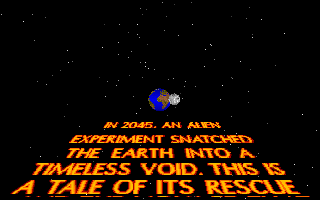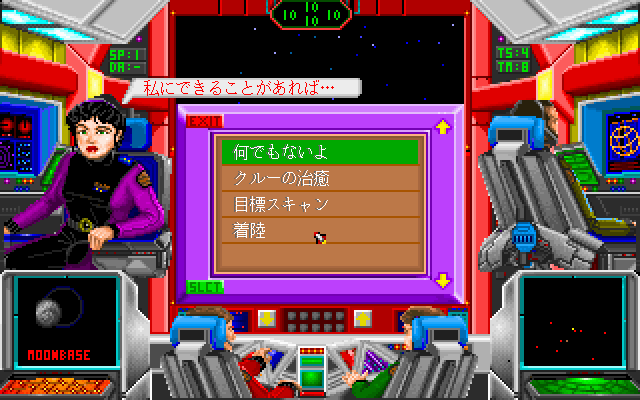Retro Replay Review
Gameplay
Planet’s Edge: The Point of No Return delivers a sprawling, open-ended experience that blends space exploration, resource management, and classic RPG mechanics. From the moment you step onto the moonbase, you’re immediately thrust into a web of systems: shipyard upgrades, crew cloning for optimal stats, and a research lab that rewards you for every alien blueprint you uncover. The lack of traditional experience points encourages creative problem solving and strategic gear acquisition, turning every new weapon and armor set into a tangible marker of progress.
(HEY YOU!! We hope you enjoy! We try not to run ads. So basically, this is a very expensive hobby running this site. Please consider joining us for updates, forums, and more. Network w/ us to make some cash or friends while retro gaming, and you can win some free retro games for posting. Okay, carry on 👍)
Navigating the star map is a delightfully tactile affair. You pilot your interstellar vessel on an overhead grid, slipping between star systems in real time. When you enter a system, the view zooms in to show planets and stellar bodies in orbit. Even though you can’t land on every world, those accessible for on-foot exploration feel rich and varied. The top-down planetary sections evoke fond memories of Ultima VI, with intricate settlements, friendly NPCs, and puzzles that demand careful observation and inventory juggling.
Combat in Planet’s Edge splits neatly into two modes: fast-paced ship battles and turn-based ground skirmishes. Space engagements keep you on your toes as you dodge enemy fire, outmaneuver hostile vessels, and target weak spots in real time. On the ground, fights slow down, giving you time to position your four-member crew, exploit cover, and employ special abilities based on each character’s unique skills. Best of all, most battles can be avoided altogether by talking your way past enemies or sneaking around—an elegant nod to player choice.
Resource gathering and trading form the backbone of your progression. You’ll spend hours mining planets for metals, liquids, and exotic organics, then ferry them back to the moonbase to craft superior gear or finance upgrades. Alien blueprints discovered in derelict sites or won from defeated foes fuel research projects, unlocking new ship modules and weapons. The thrill of returning home with a hold full of rarities makes every mining run a rewarding chapter in your cosmic odyssey.
Puzzle elements sprinkled throughout planetary settlements bring welcome variety to the gameplay loop. You might need to fetch an obscure component on one world to repair machinery on another, or leverage a NPC’s cryptic hint to open a locked door. These light brain-teasers play off the game’s emphasis on exploration, encouraging you to fully scour each enclave before jumping back into your ship. The result is a tight interweaving of action, trade, and mystery that keeps you invested from the moonbase to the farthest reaches of the galaxy.
Graphics
Visually, Planet’s Edge leans into the pixel-art style that defined many early ’90s RPGs, offering a nostalgic charm that resonates with veteran gamers. The top-down planetary vistas feature crisp, colorful sprites and well-defined tilesets that bring alien landscapes and frontier settlements to life. NPCs and environmental objects pop against muted backgrounds, making navigation intuitive without sacrificing detail.
The overhead space map is functional and clear, with star systems represented as simple icons connected by travel routes. While it may lack the sweeping, cinematic presentations of modern space sims, the clarity of the layout ensures you never lose your bearings. Planet surfaces use a grid-based overlay that highlights interactive spots—mining nodes, trading posts, and quest locations—making exploration feel purposeful rather than aimless.
Ship combat sequences switch to a more dynamic viewport where your vessel and enemy craft are rendered with distinctive silhouettes and bright weapon effects. Laser blasts, missile trails, and shield flares are modest by today’s standards, but they convey enough punch to make each dogfight engaging. Background stars and planetary rings scroll gently, adding depth to the vacuum of space without distracting from the action.
The user interface balances utility with a retro aesthetic. Menus employ simple fonts and neatly arranged icons, allowing quick access to inventories, ship modules, and character stats. Although some panels feel cramped compared to modern RPG dashboards, the designers compensated with logical groupings and color-coded highlights that guide your eye to essential information.
Cutscenes and narrative text boxes are minimalistic, relying heavily on dialogue and expository text rather than elaborate animations. This approach underscores the game’s focus on player-driven exploration and interpretation, leaving much of the drama to your imagination. While this may feel sparse to those expecting Hollywood flair, it reinforces Planet’s Edge’s identity as a thoughtful, systems-driven adventure.
Story
Planet’s Edge opens with an unforgettable premise: an alien craft penetrates our solar system, only to vanish under a mysterious electromagnetic pulse that obliterates the physical Earth. What remains is a moonbase brimming with survivors, engineering marvels cobbled together from lunar regolith, and a singular goal: reverse the catastrophe and bring Earth back from non-existence. This high-concept setup immediately raises the stakes and fuels every mission you undertake.
Your squad of four specialists—William Dean the pilot, Katya Mershova the weapons officer, Nelson Ngatadatu the engineer, and Osai Tsakafuchi the medic—provides a well-balanced team dynamic. Each character arrives with specialized skills and can be cloned for slight attribute variations, creating a nuanced layer of team customization. Their interpersonal banter and brief character moments peppered throughout the journey add warmth to an otherwise stark, survivalist tale.
The narrative unfolds organically as you voyage from star to star, gathering cryptic clues, alien artifacts, and technical schematics needed to construct the Centauri Drive. Dialogue with planetary inhabitants ranges from terse military briefings to philosophical musings on existence, and puzzles often tie directly into the larger storyline, rewarding curiosity and attention to detail. By weaving storytelling into exploration and puzzle-solving, Planet’s Edge ensures that every new discovery feels narratively significant.
While the main questline remains focused on retrieving drive components, optional side encounters give depth to the universe. You’ll broker peace between warring colonies, rescue stranded crews, and unearth long-forgotten relics of alien civilizations. These diversions enrich the overarching arc, revealing layers of history and culture that underscore the game’s central mystery.
The slow-burn pacing may test the patience of players accustomed to constant cutscenes or cinematic fireworks, but it cultivates a sense of genuine achievement when you finally piece together the Centauri Drive’s secrets. The story’s eventual payoff—a notion of restoring an entire world to existence—delivers a satisfying emotional resonance that lingers long after the credits roll.
Overall Experience
Playing Planet’s Edge feels like embarking on a grand space opera guided by your own ingenuity rather than an invisible hand. Its open-ended structure, gear-driven progression, and emphasis on resource management give you the freedom to chart your own path through the cosmos. Whether you’re plotting trade routes, delving into alien wrecks for rare blueprints, or negotiating with enigmatic star lords, the game rewards both exploration and careful planning.
Despite its age, Planet’s Edge stands out for the depth of its systems and the cohesion of its world. The interplay between mining, research, ship combat, and puzzle-based quests forms a seamless loop that remains engaging across dozens of hours. The lack of traditional XP doesn’t feel like a gimmick—it underscores the theme that survival depends on hardware upgrades, clever tactics, and meaningful choices rather than grinding.
On the flip side, newcomers may find the user interface and text-heavy storytelling a barrier to entry, particularly if they expect modern conveniences like quest markers or tutorials. The graphics, while charming, lack the polish of contemporary titles, and some planetary areas can feel repetitive after extended play sessions. A steep learning curve greets those unfamiliar with old-school RPG conventions.
For players seeking a true sandbox RPG with a hard-sci-fi twist, Planet’s Edge offers an unmatched blend of strategy, exploration, and narrative ambition. Its retro presentation is part of its appeal, and fans of deep, systems-driven gameplay will find countless hours of discovery and challenge. Strap in, assemble your crew, and prepare to venture beyond the point of no return—there’s a universe waiting to be cataloged and, ultimately, a home world waiting to be restored.
In the final analysis, Planet’s Edge: The Point of No Return is a testament to the enduring power of imaginative design and player agency. It’s not the flashiest title in the galaxy, but its intricate mechanics, vast star map, and compelling premise combine to deliver a uniquely rewarding journey. For those willing to dive into its retro folds and embrace its complexity, a stellar adventure awaits.
 Retro Replay Retro Replay gaming reviews, news, emulation, geek stuff and more!
Retro Replay Retro Replay gaming reviews, news, emulation, geek stuff and more!









Reviews
There are no reviews yet.